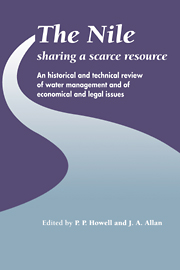 The Nile: Sharing a Scarce Resource
The Nile: Sharing a Scarce Resource Book contents
- Frontmatter
- Contents
- Preface
- List of Contributors
- Orthography
- Units and Conversion Factors
- Introduction
- I Environmental history of the Nile and its management
- 1 Origin and evolution of the Nile
- 2 History of Nile Flows
- 3 History of water use in the Sudan and Egypt
- 4 East Africa's water requirements: the Equatorial Nile Project and the Nile Waters Agreement of 1929. A brief historical review
- 5 History, hydropolitics and the Nile: Myth or reality
- II Nile management and factors affecting future management
- III Future utilisation of Nile waters
- IV Economic, international and legal issues
- Index
3 - History of water use in the Sudan and Egypt
Published online by Cambridge University Press: 05 February 2012
- Frontmatter
- Contents
- Preface
- List of Contributors
- Orthography
- Units and Conversion Factors
- Introduction
- I Environmental history of the Nile and its management
- 1 Origin and evolution of the Nile
- 2 History of Nile Flows
- 3 History of water use in the Sudan and Egypt
- 4 East Africa's water requirements: the Equatorial Nile Project and the Nile Waters Agreement of 1929. A brief historical review
- 5 History, hydropolitics and the Nile: Myth or reality
- II Nile management and factors affecting future management
- III Future utilisation of Nile waters
- IV Economic, international and legal issues
- Index
Summary
Introduction
The Nile has provided the basis of agricultural development in Egypt and the Sudan since the start of agriculture in the area about 7000 years ago. Artificial irrigation began about 5000 years ago and continued largely unchanged until the early years of the nineteenth century when use of Nile water on a significant scale started. By the end of the nineteenth century further agricultural expansion was limited by the availability of water during the low river season. This led to the provision of annual storage with construction of the first Aswan Dam in 1903 and its subsequent heightening in 1912 and 1934. Further storage was provided by dams at Sennar (1925), Jebel Aulia (1937), Roseires (1966) and Khasm el Girba (1966). In more recent years the total availability of Nile Waters rather than its seasonal availability became the constraint and the main reason for the construction of the Aswan High Dam (1963). The enormous storage provided by the Aswan High Dam enables the variations of the Nile flows from year to year to be evened out and the potential of the Nile to be utilised. Until recent years the use of Nile Water has gradually increased, keeping pace with the increase in population. Egypt and the Sudan are now, however, faced with the prospect of continuing population increase but with only limited further Nile water available for agricultural expansion.
- Type
- Chapter
- Information
- The Nile: Sharing a Scarce ResourceA Historical and Technical Review of Water Management and of Economical and Legal Issues, pp. 65 - 80Publisher: Cambridge University PressPrint publication year: 1994
- 5
- Cited by


